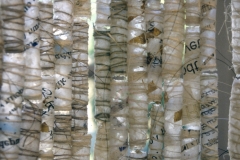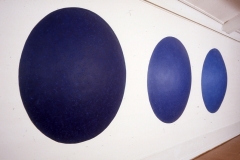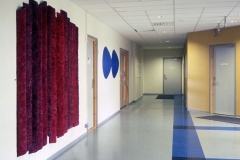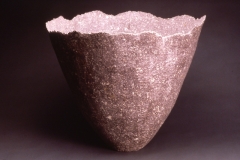Ise 1 and 2
2022
72 x 57 , Cotton and abaca fibers, pigment, lace fragment, linen, and silk thread. Paper cast in a plaster mold.
Discovering paper as a medium was a revelation to me as an artist, some forty years ago.Paper, this humble and cheap way to express oneself, felt like a great gift from the Far East, and it soon started to play an important role in my work.
Going to Japan, it was astonishing to see the role that paper played in the culture. The title «Ise»reflects my interest in Zen Buddhism and Shintoism, which is Japans old nature-worshipping religion. The Ise Jingu Shrine is the most sacred Shinto site.
One of the qualities of paper is that it rapidly reflects the texture of the surface on which it dries. In order to create a marble-like surface, «Ise» was cast in a plaster mold.
Blue Devi
2022
115 x 250 cm, wall installation consisting of 125 items
Cotton and linen thread, silk, kozo, and cotton fibers. Lace, knitting, weaving, and crochet. Paper cast in plaster molds.
When traveling in India many years ago I met the gods and goddesses: Brahman, Vishnu, Shiva, Krishna, Durga and a myriad of others within the Hindu universe. I also visited the Bodhi Tree where Buddha is said to have his enlightenment.
Coming home, I could not forget about the Hindu goddesses, they made a strong impression on me; so far from my nordic culture and at the same time so human and close -. Also the fact that they were often portrayed blue filled me with wonder.
I wanted to make a memory piece, and eventually, after a long time, I came up with the wall installation Blue Devi, where Devi refers to a devine mother goddess in Hinduism.
Deva and Devi
2011
H: 7 cm – W: 5 cm – D: 4 cm Paper cast. Kozo fibres and crochet laces.
When traveling in India you will inevitably meet the gods and goddesses: Brahman, Vishnu, Shiva, Krishna, Durga and a myriad of others within the Hindu universe. On top of it all you also meet Buddha, as Buddhism, one of the worlds largest religions, was founded in Ancient India. To visit the celebrated Bodhi Tree, where Buddha is said to have his enlightenment was a must when I traveled in India in 2010.
Coming home I made these «buddha- like» heads; Deva and Devi. Deva is Sanskrit for God or Deity. Devi is the feminine form of Deva.
Ultima Thule
1996
260 x 310 cm. Installation.Paper cast.Linen tread, linen and flax fibers.
In 1996 I was invited to take part in the «Bienniale de Lin» in Normandy. My contribution was the installation Ultima Thule. The theme include war and destruction, with inspiration taken from Tu Fu, a famous Chinese poet from 8th century . Fragments of text are used as elements in the work itself, they are like letters of complaint blowing in the wind.The white color represents both purity and sorrow.
Straumar/Currents
1997-1998
Gjertrud Hals and Helga Bøe
Dia150 cm d 25 cm Sculpture, series.Installation. Cotton, flax and kozo fibers, cellulose glue. Paper cast.
For about 10 years, on various occasions, I worked with the artist Helga Bøe. Both of us were interested in monumental works, and these are easier to produce in collaboration with someone.
We often worked with geometric shapes; circles, squares and cubes. We also did many experiments with color, like in Straumar.
In this installation we tried to bring out the currents in the water and the dark blue color at great depths, becoming gradually lighter.
Black Sun, Thule and Trio
1995
Black Sun: diam 150 cm, d 7cm. Relief, cotton and flax pulp, paper cast.
Tule: 8 x 8 cm, h 80 -110 cm, 11 parts. Sculptures, cotton and flax pulp, compressed in «inner molds»
Trio: ca 8 x 60 x100 cm, 3 parts. Sculptures, cotton and flax pulp, compressed in «inner molds»
The three sculpture groups have often been exhibited together, as an installation; a Requiem Mass. The main motif, the black sun, is taken from Voluspå. In the apocalypse of Norse mythology the sun turns black and falls into the sea, before the world is destroyed and a new world is born.
The pillars represent the creation myth, in which the gods create the first humans from logs; Ask and Embla. Technically Tule and Trio are far from my earlier membranes, as these are solid and heavy, and raw in their expression.
Kvadrat og skjold / Square and Shield
992 -94
Kvadrat/ Square: 50 x 50 cm, d 20 cm. Relief, cotton pulp, cast in a plaster mold.
Skjold/ Shield: diam 100 cm, d 10 cm. Relief, cotton pulp, cast in a plaster mold.
Both of these artworks were made in series. The «wounded shields» are some of my artworks from this period, dealing with war and vulnerability. This was the time of the Balkan wars, that shocked in their brutality.
The road to Ise
1992
110 x 130 cm, 5 parts. Kozo and abaca fibers. Paper cast in a plaster mold.
Discovering paper as a medium was a revelation to me as an artist, and it soon started to play an import role in my work. One of the qualities of paper is that it can rapidly reflect the texture of the surface on which it dries. In order to create a marble-like surface, The Road to Ise was dried on a plaster mold. The title reflects my interest in Zen Buddhism and Shintoism, which is Japans old nature-worshipping religion. The Ise Jingu Shrine is the most sacred Shinto site.
Fence/Stengsel
1991
Red Fence: 240 cm x 280 cm, and different sizes. Relief. Cotton, linen and cellulose fibers. Paper cast.
Stengsel /Fence was another of my favorite themes in the 1990s. I made them in different sizes and colors, as free standing sculptures and as wall reliefs. I was very interested in paper techniques in this period; the quality of the fibers, how to use fibers for different purposes, how to protect the surface, and so on.
For two seasons I was growing my own linen( too much work! ), and I also went to the acquisition of a Hollander Beater to make my own paper pulp.
Lava
1987-1990
Diam 80 cm -100 cm, h 80-110 cm. Sculpture, series. Installation. Cotton, cellulose and linen fibers. Paper cast.
Since the early 1980s I had been experimenting with producing and using paper as a material. The result of this striving was the Lava series; monumental, monochrome urns cast in paper. This is what I wrote about Lava when they were internationally presented in 1987:
Pots/vessels/containers. Concrete universal shapes with a wide range of associations, everything from utensils used for ritual purposes to those in everyday use.
The container is very ancient, but also timeless, always pointing to the future.
To contain something, embracing materials with an outer protective shell, is one of life´s fundamentals. Premature fracture of many fragile protective shells -membranes- means almost certain death or destruction. On the other hand, cleavage at the right moment can mean life liberating itself, or even an idea or thought which breaks forth and materializes in creativeness.



































































